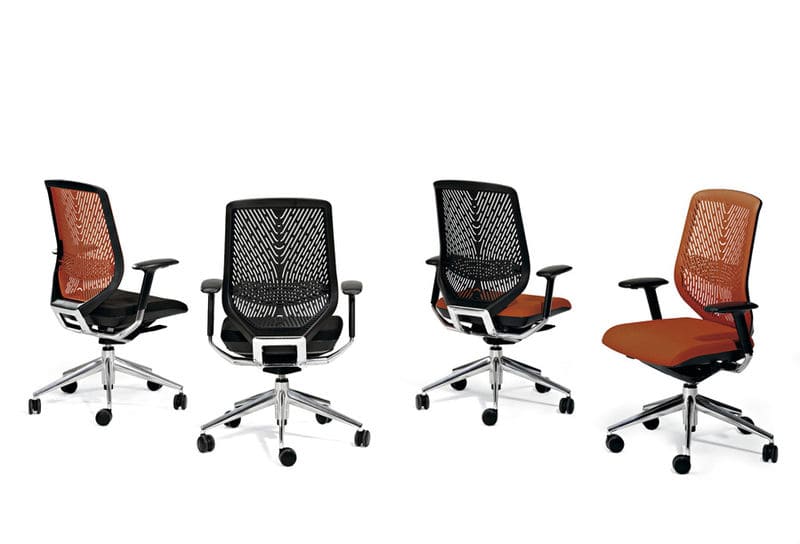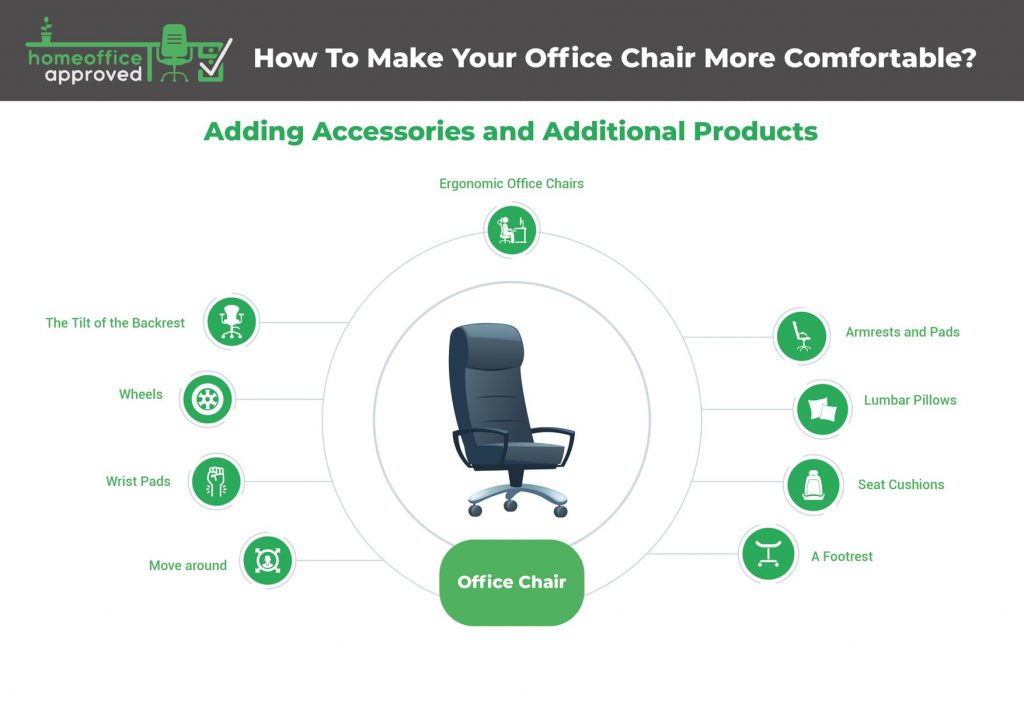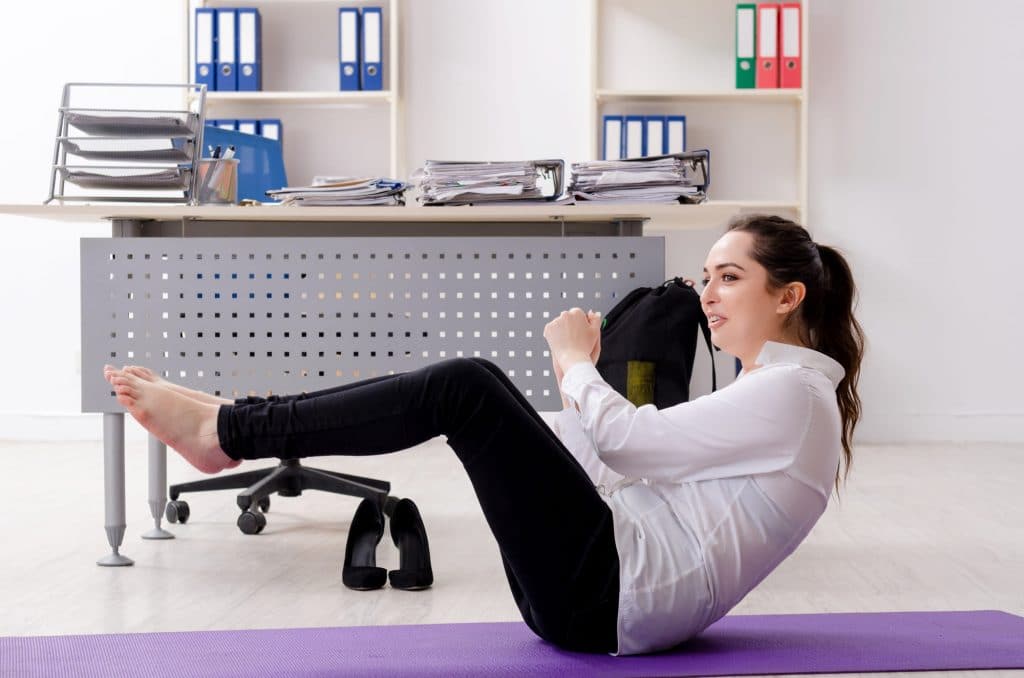*When you buy through links on our site, we may earn an affiliate commission at no additional cost to you.

Do you know the feeling when your butt slowly falls asleep and your neck is getting stiff from sitting in front of your PC for too long? When you just can’t find a comfy position on your office chair anymore no matter how you turn and twist yourself?
I certainly do and a lot of people can probably refer.
Also, not everyone has or is willing to spend the money for a $1000 ergonomic chair, so let me show you how to make your office chair more comfortable with a couple of tricks and gadgets.
Thus you won’t have to spend a fortune on a chair but still, get rid of the discomfort. Also, you will prevent a lot of risk factors and diseases that come with sedentary work.
So let’s dive into the tips to make your work comfier.
Table of Contents
How To Adjust Your Chair
The very first thing you need to keep in mind is, that you need to adjust your office chair (or desk) for the proper ergonomics.
Even the best ergonomic chair won’t help you if you don’t use its adjustments in the right way.
There are two ways to start, depending on your office furniture. First, adjust your seat and find the right seating position, then adjust the table height if you can, to fit your seat.
But most desks start at a height of 30 inches. That can be a problem for “shorter” people because they won’t reach the floor with their feet anymore when adjusting the chair to the desk top height.
So it’s easier to adjust the chair first and then follow up with the desk, but let’s assume your desk is too high. (If it’s adjustable in height just start with the right seating position)

To make your office chair more comfortable make sure to follow these guidelines:
- Adjust the proper chair height. When typing, your arms should be able to rest comfortably on your desk at a 90 degree elbow angle, so the keyboard feels like a natural extension of your arms.
- The armrests of the office chair should be roughly the same height or a little lower than your desk. The whole goal here is a relax your shoulders. When your arms can rest comfortably, your shoulders can also relax.
- Slide to the back of the chair to improve your lumbar support. You shouldn’t sit at the edge of the seat with your back in a rounded posture because that will cause pressure in the lower back. Add a seat cushion or lumbar pillow, that can also help to increase lumbar support to prevent back pain.
- Your feet should be able to stand flat on the ground, while your knees are also roughly at a 90 degree angle. If your feet don’t touch the ground you’ll always tend to lean and bend over. Most people won’t have an adjustable desk so they can only change their chair height. Thus you’ll need a footrest or a little hammock for your feet.
- Adjust the height of your monitor so the upper frame is at your eye level. If you work on a laptop you should consider a laptop stand and an extra keyboard, so you don’t have to look down on the display constantly because that will cause neck stiffness. Alternatively, you can plug your laptop into another monitor that has the proper height on eye level.
These are the basic adjustments to make your office chair more comfortable.
You should find a comfortable seating position when you slide back in the chair and your feet can rest on the ground while having n angle of about 90 degrees at your knees and elbows while your forearms rest comfortably on the desk.
Now let’s take a look at the extra steps you can take to increase your comfort to the next level.
Adding Accessories and Additional Products
Ergonomic Office Chairs

When you care about your back and overall health, you want to invest in an ergonomic chair. It’ll give you more options to adjust your chair to all of your body proportions.
There is no “perfect” height for your chair according to your body height, so just ignore those tables you find online about that.
Every person is different and those tables only give you a very rough estimation, because we strongly differentiate with our proportions.
The more adjustments you can make with your chair, the easier you’ll set it up for your needs. Always make sure to test all of the adjustments and settings.
Related article: Check out the best ergonomic office chairs on the market.

Armrests and Pads
Personally, I’ve been looking for the “perfect” office chair for myself for quite a while before I made a decision. But after using the chair for a while I noticed one of the things that really annoyed me: The armrests were too long.
The chair armrests were padded and super comfortable, but when I tried to get closer to my desk I couldn’t, because the armrests blocked me from it. Thus I couldn’t rest my arms on the top comfortably.
So here is my pro tip: Get an office chair with short armrests.
I just removed mine, so I could comfortably reach my keyboard while typing. There is also another reason to remove the armrests.
When they aren’t adjustable and too high, or just not suitable for your body, so your arms can’t rest on them relaxed forcing your shoulders up, bringing tension to your neck.
Also, make sure your armrests are padded unless you want elbow pain from resting on hard surfaces for hours.
You don’t have pads? No problem, you can get armrest pads on amazon. Just attach those armrest pads to your office chair and you’re good to go.
Lumbar Pillows

A lot of desk chairs have a fairly huge seat, which can be quite uncomfortable for smaller persons with shorter thighs.
That can impact the blood flow to your calves and cause some tingling and numbness.
Naturally, you’ll sit more towards the edge where your pelvis won’t touch the backrest causing a lack of lower back support and a bend-over posture as well as back pain[1].
The simple solution: Support pillows
Any pillow you can find is better than having no support at all.
But you can also get a special lumbar pillow for a couple of dollars on Amazon.
Not only it’ll make your office chair more comfortable, but it’ll also save you from back problems in the long term.
You might think it’s counterintuitive to sit more towards the edge of the seat…which is true, but it makes sense when the office chair is too big.
So when you have shorter thighs, move a bit forward on the seat and support your lower back with a support pillow.
Seat Cushions
One of the most common ways to make any desk chair more comfortable since the beginning of sitting is a simple cushion.
After a lot of usage, any padding becomes weaker and harder.
You can use a simple pillow in your household you can spare or buy a special seat cushion for sedentary work or even use memory foam.
For the long-term, I would definitely recommend a seat cushion with memory foam to eliminate any kind of discomfort from hard seating surfaces.
A Footrest
Many of us have adjustable office chairs, but not adjustable desks. Even though I have a standing desk, its minimum height is 30 inches.
For shorter people (like me) that means my feet can’t properly touch the ground when my office chair is high enough that my arms can rest on the top.
Get something to rest your feet on. A footrest, a hammock, or any kind of box that enables support for your feet, so they don’t dangle in the air.
The Tilt of the Backrest
Finding the right angle for the back can be a little difficult. You don’t want to lean back to chill, but sit comfortably and be productive.
When you lean back too far your pelvis will slide away to the front of the seat, leaving you in an unhealthy c-shape posture. If leaning towards the monitor, the folded posture will cause pressure in your hips, and restrict the blood flow to your legs.
Find a position that allows you to stay at the backrest (or cushion) with your lower back but allows you to lean back a little, so the angle in your hip-joints opens up a little.
Wheels
Most office chairs have wheels. But if yours hasn’t you should add some. They allow you to move around more freely and find the proper position faster.
You won’t need to pull around your static chair every time you stood up to take a break or go to the toilet.
So add some casters and a chair mat to protect your floor at home.
Wrist Pads
Now we discussed all the options you have to improve the comfiness of your chair. But let’s keep going a little and also improve the details.
To prevent a tennis arm from computer work, your wrists should be straight all the time. Get a wrist pad to improve the angle of your forearms.
Also, it’ll help to remove the unpleasant feeling of the hard edge under your forearms.
Move around
There you go. Now you know the best tips to guarantee everlasting comfort while working on your computer.
But there is more. Even with the perfect desk setup and seating positions you should always move around as much as possible when you feel like getting a little stiff.

Take breaks, stand up maybe stretch a little and be active. It’s vital to move as much as possible because that’s how the metabolism of your vertebral disks works. We’re made for moving so never sit for elongated periods of time!
Also, consider stretching your chest and hips to prevent hypertension in those areas.
Consider getting a standing desk as well so you can stand up while working.
Conclusion: Make Your Office Chair More Comfortable
Making your desk chair as comfortable as possible can be tricky and a lot of factors come into play.
Sometimes it’s just not the right size or proper adjustments. But if you follow the tips and everything is properly set up you can improve the comfortability of your chair by adding some extra products like a seat cushion with memory foam, an armrest pad, or a footrest.
Sedentary work has a lot of negative side effects like back pain, weight gain, or increased risk for heart disease[2]. So even if you have the most comfortable desk chair setup you should always try to move around as much as possible and take active breaks to prevent sitting all day long.



